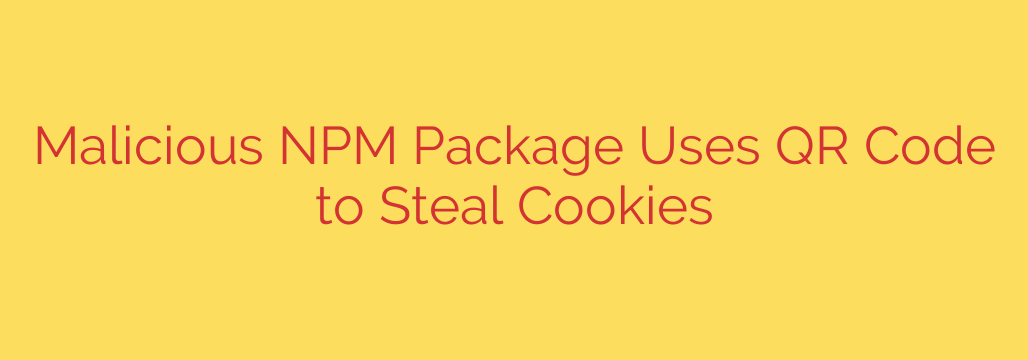
Developer Alert: Malicious NPM Packages Use QR Codes to Steal Cookies and Hijack Accounts
The software supply chain is a constant target for attackers, and a new, alarmingly clever technique has emerged that targets developers directly through the NPM ecosystem. This method uses a simple QR code displayed in the command line to trick developers into compromising their accounts, leading to session hijacking and data theft.
This attack vector is particularly dangerous because it bypasses many traditional security measures by relying on social engineering. It preys on the trust developers place in their tools and the common use of QR codes for authentication.
How the QR Code Attack Works
The attack unfolds in a few simple but effective steps. It begins when a developer installs a malicious or compromised package from the NPM registry.
The Bait: A developer installs a seemingly legitimate NPM package for their project using a command like
npm install. The malicious code is hidden within this package, often in apostinstallscript that runs automatically after the download is complete.The Hook: Once the installation script runs, it generates a QR code directly in the developer’s terminal. This is accompanied by a deceptive message urging the user to scan the code. The message might claim it’s for verification, linking a GitHub account, or enabling a special feature.
The Scan: Believing the prompt is a legitimate part of the package’s setup process, the developer scans the QR code with their smartphone. This is a common action for logging into services like Discord or WhatsApp Web, making the request seem plausible.
The Theft: The QR code contains a URL that, when opened on the phone, executes a script to exfiltrate sensitive information. The primary target is authentication tokens and session cookies from applications like Discord, which are often stored by the browser. These stolen credentials are then sent silently to a server controlled by the attacker.
The Takeover: With the stolen session cookies, the attacker can now impersonate the developer, gaining full access to their accounts without needing a password or even triggering a two-factor authentication (2FA) prompt.
Why This Threat is So Potent
This attack method is especially effective because it exploits human behavior rather than a software vulnerability. Developers are accustomed to seeing various outputs in their terminal and are often focused on the task at hand, making them susceptible to a well-crafted social engineering ploy.
The potential damage from a successful attack is significant. An attacker with access to a developer’s accounts could:
- Steal private source code from repositories.
- Inject more malicious code into projects, spreading the attack to other developers and end-users.
- Access sensitive company data through platforms like Slack, Jira, or internal wikis.
- Pivot to other systems by leveraging credentials stored or accessible from the compromised accounts.
This represents a serious supply chain risk, as a single compromised developer can become an entry point into an entire organization’s infrastructure.
How to Protect Yourself and Your Organization
Vigilance is the best defense against this type of threat. Developers and security teams must adopt a more cautious approach to package management and be aware of these evolving tactics. Here are critical steps you can take to stay safe:
Be Skeptical of Unexpected Prompts: An
npm installcommand should never ask you to scan a QR code. Treat any such request in your terminal as an immediate and serious red flag. Legitimate authentication processes will not happen this way.Vet Your Dependencies: Before adding a new package to your project, perform due diligence. Check its download statistics, release history, and the number of maintainers. Be wary of new, unpopular, or typosquatted packages (packages with names similar to popular ones).
Use Security Scanners: Integrate automated security tools into your workflow. Services like
npm audit, Snyk, or Socket.dev can scan your dependencies for known vulnerabilities and suspicious behaviors, alerting you to potentially malicious packages before they can do harm.Isolate Build Environments: Whenever possible, run installation and build processes in isolated or containerized environments, such as Docker. This can help limit the “blast radius” of a malicious script, preventing it from accessing sensitive files or credentials on your primary machine.
Practice Zero Trust with QR Codes: Treat QR codes from unverified sources with the same suspicion as you would a phishing link in an email. Never scan a code unless you are absolutely certain of its origin and purpose.
As attackers find more creative ways to infiltrate development workflows, the responsibility falls on every developer to remain vigilant. By understanding these new threats and practicing strong security hygiene, you can protect yourself and your projects from compromise.
Source: https://www.bleepingcomputer.com/news/security/npm-package-caught-using-qr-code-to-fetch-cookie-stealing-malware/








